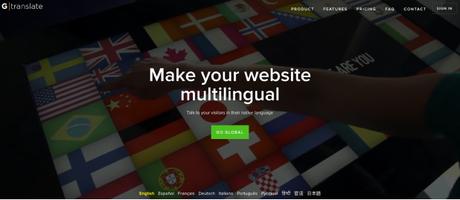In baseball and in business, there are three types of people. Those who make it happen, those who watch it happen and those who wonder what happened.
Tommy Lasorda
You're probably wondering - what does this mean? And more importantly - what does this have to do with me and my Shopify store?
So, you operate an e-commerce store on Shopify. You're proactive and eager to stay ahead of competitors - that's why you've already integrated competitive intelligence apps, giving you competitor insights that are helping you make strategic business decisions.
However, growth has stagnated in the past while, or maybe it's just not exactly where you envisaged it would be by now. You're wondering what else can be done to stay ahead of the game. The answer to this: a multilingual Shopify store.
What's a multilingual Shopify store and why do I need one?
Suppose I sell product X. The market size for this product is 100, however, I've decided to target 25% of it. Sounds preposterous, right? Well, that's because it is.
Unfortunately, this is the reality that many businesses, especially those selling on online platforms, unknowingly find themselves in. In 1996, more than 80% of internet users were native English speakers. Flashforward to 2010 and this figure had dropped to 27.3%.
Today, it is estimated that only 25% of internet users are native English speakers. Moral of the story? More than 75% of internet users want to browse, and buy, in other languages.
Still not convinced? Not to worry - let's take a quick look at some of the specific benefits associated with a multilingual Shopify store.
Benefits of a multilingual Shopify store/website
Landing and Product pages
It will come as no surprise to anyone that a consumer's propensity to purchase a product (or service) online significantly diminishes if they can't understand what they're reading.
Landing and product pages are essentially the first impression a customer has of the business and what it provides. If this isn't translated accurately, or even worse, at all - don't expect the website visitor to make a purchase.
Business Expansion
Translating your website into multiple languages will make it accessible to a whole new segment of consumers from markets you weren't even aware you had access to.
As the old salesman adage goes, your pitch needs to be tailored to each person based on how they want to communicate and what they're hoping to hear.
Therefore, by making efforts to translate your website you'll attract a whole new consumer group which will constitute the expansion of your business.
Building Trust and Brand Recognition
When you take the important step of integrating a translation solution into your website, more people will visit it which leads to a greater awareness of your brand on a global scale.
Businesses who successfully operate multilingual e-commerce platforms give themselves a competitive advantage in the global marketplace. Customers will associate this multilingual functionality with high standards and will increase their trust in the brand.
Therefore, it's important that you recognize the added-value that a multilingual dimension could add to your business in terms of not only growth but also credibility.
How to translate your Shopify Store
So now you know why you need to make your Shopify store multilingual, but now it's time to look at the how. Luckily for you, transforming your Shopify store into a multilingual one has never been easier thanks to a number of Shopify translation apps.
Each of these apps can integrate into your store and display them in a variety of languages, albeit to varying degrees of sophistication.
Let's take a look at some of these apps in more detail to help you decide on which solution might be best for your business:
The final translation solution we're going to look at is the Weglot Shopify translation app. The app boasts a seamlessly simple 5-minute set-up process to both automatically translate and display your Shopify store.
This involves adding and installing the Weglot translation app, creating a Weglot account, and then following this, you simply enter the original language of your site and the language(s) you would like to translate it to.
The Weglot dashboard allows users to both manage and edit the automatic translations of all your content on Shopify, this includes any content you've created using other Shopify apps.
There is also the option of ordering professional translations if they are required.
Noteworthy features of Weglot include:
- multilingual SEO optimized with translated metadata meaning that translated URLs (these will be visible to search bots only) and Hreflang tags are automatically implemented on your site.
- automatic language detector and auto redirection feature meaning that the visitor's preferred language can be automatically displayed.
- fully customizable language switcher
- a rigorous customer support team who respond within 1 business day
It's also worth noting that the Weglot app translates your whole check out process and also integrates seamlessly with invoicing to facilitate your customers.
GTranslate:

Offering translation services in over 100 languages, GTranslate combines the abilities of Bing and Google's automatic translation services in order to make your Shopify store multilingual.
Conveniently, a free version of the app is available to download on Shopify. However, it's important to note that a number of key features such as editing translations, and the incorporation of multilingual SEO are exclusive to paid plans.
Paying users get access to the GTranslate dashboard which facilitates the editing of automatic translations. Additional features include the ability to monitor the traffic generated on the translated pages.
The app places a language switcher on your site so visitors can choose their language of choice as appropriate, however, it's worth noting that any customization of this language switcher will require contact with the team at GTranslate or some expertise in coding.
Langify
Another option at your disposal is Langify. The app eliminates the need for the creation of multiple websites (i.e one for each language) and allows visitors to view translated content in their desired language via a language switcher. Langify does not, however, offer automatic translation of your content, unlike most translation solutions.
The app acts as a translation manager. The process involves the user providing and uploading the translations themselves, and then editing and managing these translations via the Langify dashboard. In this respect, Langify is one of the more time-intensive translation solutions available.
A key feature of the Langify translation solution is the automatic language detection feature. This means that depending on the language of the website visitor will be automatically detected based on their browser settings.
As a result, they are redirected to their preferred language in a domain which is specific to that language. These individual domains can also have Ahreflang tags and other associated metadata translated to help with SEO.
When it comes to the checkout phase for customers, it's worth noting that the Langify solution does not allow the whole process to be fully translated which may require seeking an additional app or finding an alternative solution.
Which is the right Shopify translation solution for you?
Only you can determine which Shopify app is right for your translation needs. However, when making your decision, be careful not to make the mistake of sacrificing long term value for short term price savings, and also, be mindful of the following:
Languages available
While a translation app may support many languages, this doesn't necessarily mean they support the language you need for your website. Be prudent and check out the app's site to make sure the language you need is provided for.
Automatic vs Human Translations
When it comes to Shopify apps, there are two primary methods of translation available - automatic and human translation. The best solutions are those who combine the time and efficiency of automatic translations with the option to incorporate human translations via translation editors or by linking up with professional translators
UX and Setup
Chances are - you're not a developer, and so, it's in your interest to be using an intuitive and user-friendly application. No one wants to have to get caught up in a convoluted installation process or work with large amounts of code to translate their site.
Finding a Shopify app that will make this process as seamless as possible will save you both time and a lot of unnecessary stress.
Design Integration and Level of Customization
Make sure to research how the app will impact the design of your existing site, also look into the adaptability of your translation solution, for example, are there options to customize the language switcher?
Customer Support
For those venturing towards making their sites multilingual for the first time, you may find yourself with lots of questions initially. Therefore, it's important to check out what kind of support is being offered by the solution you choose.
s there extensive documentation, guides, and FAQs? Is there a dedicated customer support team? If so, this can greatly facilitate the process.
SEO
If you want to place higher on SERPS ( and why wouldn't you?) you need to ensure that the solution you choose is SEO friendly, and ideally, following Google best practices.
When your metadata, including titles and descriptions, is translated you can target a broader range of keywords, this will improve your chances of ranking higher.
Parting Words
So, it's clear that multilingual websites will play an increasingly vital role in the future of e-commerce. At the start of this article, I made a bold statement in the words of Tommy Lasorda - Former Major Baseball League Pitcher, Coach, and Manager.
In baseball and in business, there are three types of people. Those who make it happen, those who watch it happen and those who wonder what happened'
Tommy Lasorda
Given the hyper-competitive business environment we operate in nowadays, and the frenetic pace at which it is evolving, this quote is very much applicable to the question of translation and e-commerce.
- Will you make it happen? Integrating a translation app and get an edge over your competitors?
- Will you watch idly while your competitors get ahead and diminish your market share?
- Or, will you look back in 5 years' time scratching your head, wondering where it all went wrong?

